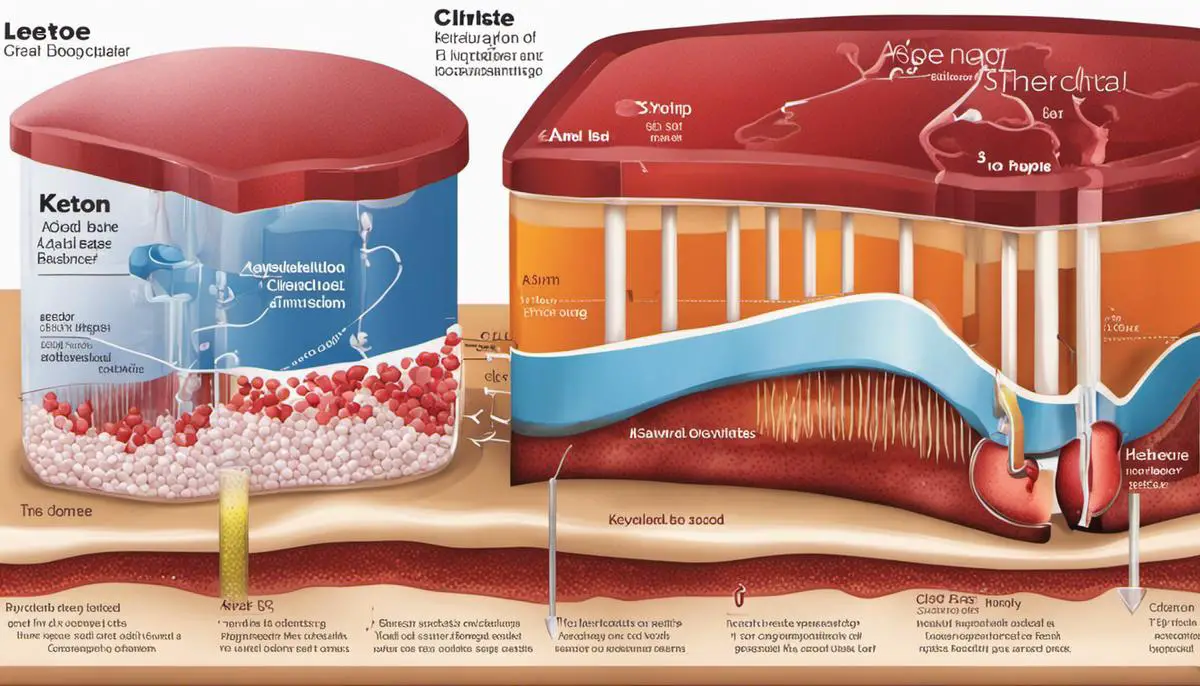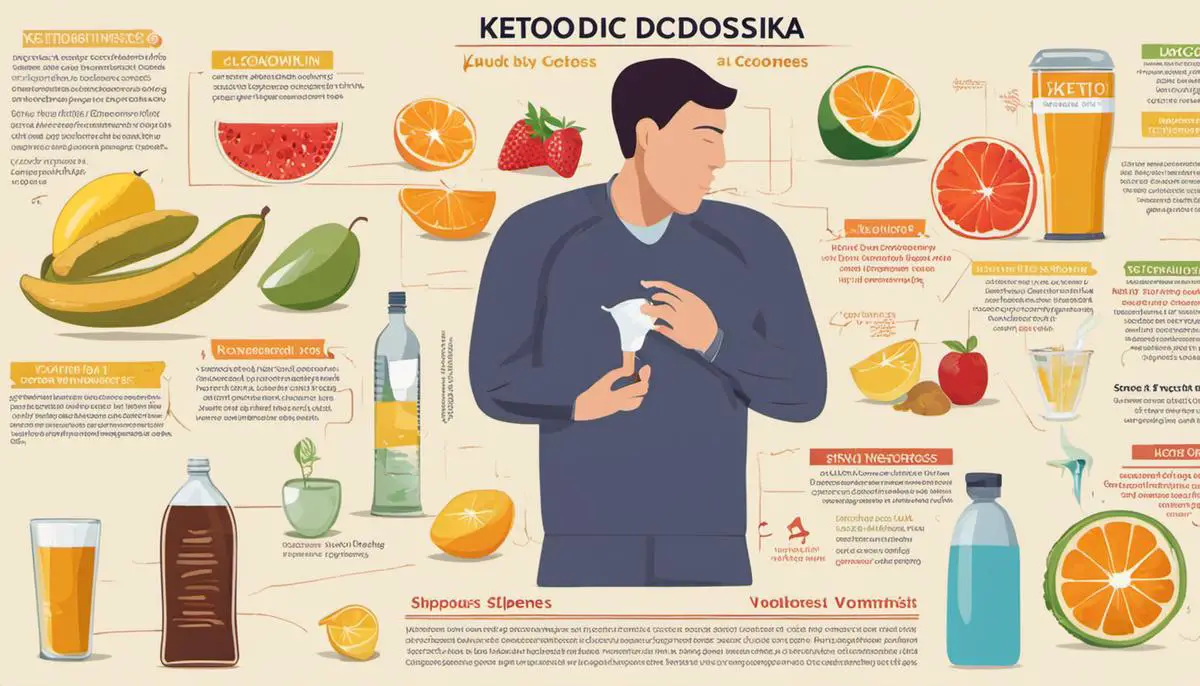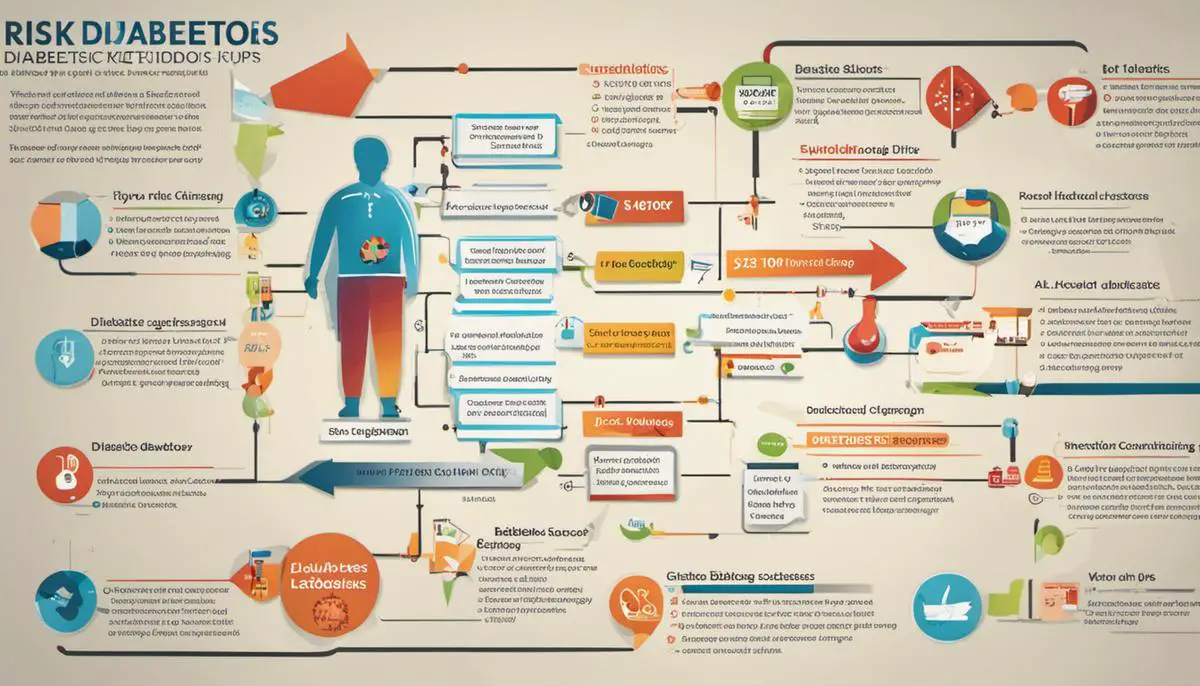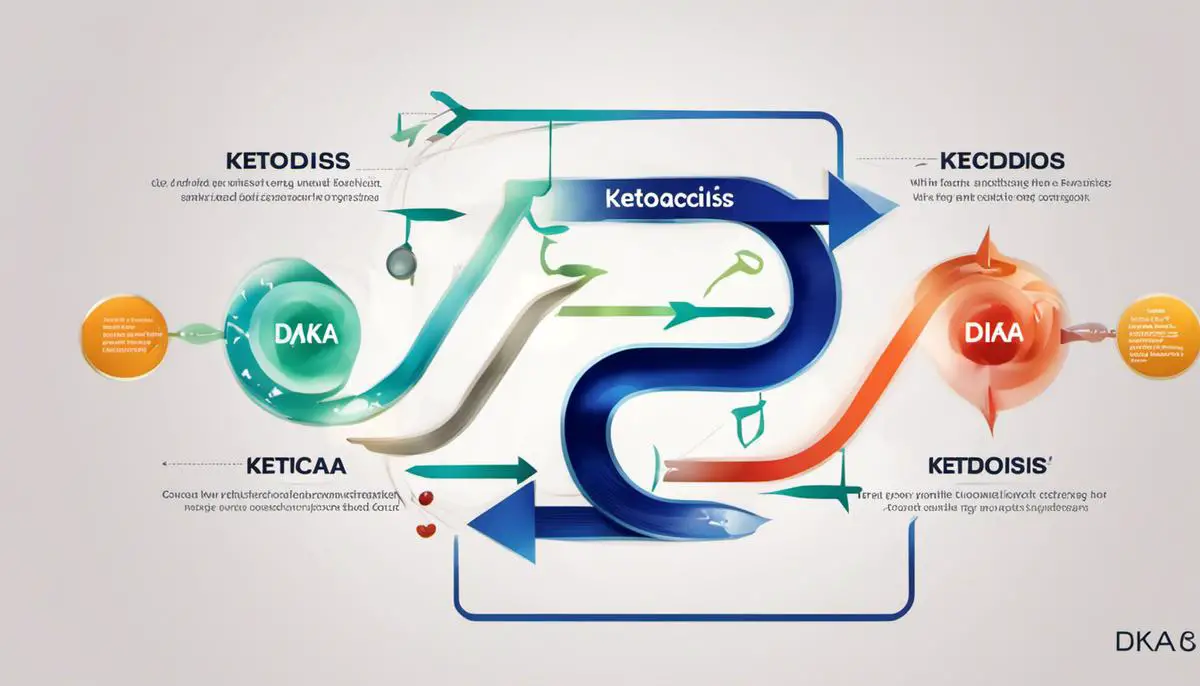When it comes to understanding the intricate workings of the human body and the diseases that affect it, clarity and knowledge are key. Two such conditions, Diabetic Ketoacidosis (DKA) and Ketoacidosis, often cause confusion due to their similarities, but understanding their subtle differences is critical for effective prevention, diagnosis, and treatment. Both conditions revolve around the body’s metabolism, and how it reacts to the availability of insulin and glucose, but their presentation and management can differ significantly. In this discussion, we’ll delve into a comprehensive exploration of DKA and Ketoacidosis, shedding light on their definitions, causes, symptoms, diagnostic procedures, treatment options, risk factors, prevention strategies, and even provide real-life case studies to bring those theoretical concepts to life.
Defining DKA and Ketoacidosis
Defining Diabetic Ketoacidosis (DKA)
Diabetic ketoacidosis or DKA is a serious medical condition that occurs when your body doesn’t have enough insulin. Insulin is a hormone that helps transport glucose from the bloodstream into cells, where it is used for energy. When the body lacks insulin, cells can’t take in enough glucose, leading to a deficiency of energy.
To compensate for this deficiency, the body starts to break down fat cells to produce energy. This produces substances called ketones, which are acidic. An excessive buildup of these ketones can make your blood too acidic, resulting in DKA. This condition is most common in individuals with type 1 diabetes but can also occur in those with type 2 diabetes under certain circumstances, like severe illness.
DKA symptoms can include thirst, frequent urination, nausea, abdominal pain, weakness, and confusion. In severe cases, it can lead to a life-threatening diabetic coma or even death.
Defining Ketoacidosis
Ketoacidosis is a broader term referring to a metabolic state where the levels of ketones are elevated in the body, leading to a more acidic blood pH. This can occur as a result of prolonged fasting, alcoholism, sustained intense exercise, or a ketogenic diet, where the intake of carbohydrates is significantly restricted, and the body relies heavily on fat for energy.
In the realm of diabetes, ketoacidosis most commonly refers to DKA. However, another specific form of ketoacidosis is alcoholic ketoacidosis, which occurs from excessive consumption of alcohol.
DKA Vs Ketoacidosis: Comparisons and Contrasts
In terms of similarities, both DKA and general ketoacidosis involve the elevation of blood ketone levels and a drop in blood pH to more acidic levels. They each also represent the body’s shift from using glucose as an energy source to breaking down fat.
Contrasting factors largely surround the root causes and risks associated with each condition. DKA is specific to diabetic individuals, particularly those with type 1 diabetes, and is often triggered by situations such as missed insulin doses, infection, or serious illness. General ketoacidosis can arise from a broader range of scenarios, including extreme dieting, alcoholism, or prolonged fasting.
While DKA can become a medical emergency in a short duration, ketoacidosis induced by other causes tends to evolve over a longer period, and its treatment typically involves addressing the underlying cause such as reintroducing carbohydrates into the diet or treating alcoholism.
Understanding Medical and Biological Processes
Diabetic Ketoacidosis (DKA) and ketoacidosis are both serious conditions which result from the body’s shift towards breaking down fat due to a lack of glucose used for energy. When this metabolic switch occurs, the body begins to produce ketones, which are acidic by-products left over from fat metabolism. An increased volume of ketones in the bloodstream can lead to a greater acidity in the body’s environment, disrupting essential bodily functions and necessitating immediate medical intervention. Both DKA and ketoacidosis are, therefore, serious situations that cannot be ignored.

Symptoms and Diagnosis
Symptoms of DKA and Ketoacidosis
Both DKA and ketoacidosis share common symptoms due to an elevation in the level of ketones in the blood. Such symptoms can include increased thirst, frequent urination, feelings of nausea, vomiting, stomach pain, a shortness of breath, a sense of confusion, fatigue or sleepiness, and a breath that might be occasionally described as having a fruity odor.
Although DKA generally develops at a slower pace when compared to classic ketoacidosis, which can often progress within just a day, the timeline may vary from individual to individual. In more severe scenarios, these conditions can lead to the patient falling into a coma or even death if not treated promptly.
When to Seek Medical Help
Should you or someone you know display any of these symptoms, it is important to seek medical advice immediately. The presence of high blood glucose levels alongside the aforementioned symptoms could be indicative of DKA or Ketoacidosis and must not be taken lightly.
Diagnostic Procedures and Tests
Doctors often diagnose these conditions through blood tests. The tests are designed to detect elevated levels of blood sugar, ketones, and acid in your blood. Other tests such as urinalysis may be conducted to check for the presence of glucose and ketones in your urine. A chest X-ray, electrocardiogram (EKG), or other tests may also be performed to check for any complications.
Other important factors in the diagnosis are the patient’s medical history, symptoms, and a physical examination. The doctor will look for signs of dehydration, difficulty breathing, confusion, and other symptoms associated with DKA and Ketoacidosis.
Distinguishing DKA from Ketoacidosis
Though the terms DKA and Ketoacidosis are sometimes used interchangeably, they are not the same. DKA, a complication of diabetes, is typically caused by an absolute or relative deficiency in insulin. This can lead to high blood sugar levels, and the body may begin to break down fat for energy, thereby producing ketones and leading to DKA.
On the other hand, Ketoacidosis can occur as a result of alcoholism, starvation, a severe infection, or an overactive thyroid. It essentially refers to a metabolic state associated with high concentrations of ketone bodies, formed by the breakdown of fatty acids and the deamination of amino acids.
The seriousness of both Diabetic Ketoacidosis (DKA) and Ketoacidosis cannot be overemphasized. However, with diligent monitoring of blood glucose and ketone levels, ensuring you stay properly hydrated and are able to recognize when immediate medical attention is necessary, both conditions can be managed and prevented.

Treatment and Management
Addressing DKA
DKA is a severe condition, with potential consequences including diabetic coma or even death, it’s treatment therefore necessitates a comprehensive approach. This typically includes insulin therapy along with fluid and electrolyte replacement.
Effective management of DKA heavily incorporates insulin therapy, which works to lower raised blood sugar levels by promoting sugar absorption in cells. The initial emergency treatment for DKA often requires a constant intravenous insulin infusion. Once blood sugar levels have stabilized, under-the-skin insulin injections may be implemented instead.
It’s also imperative to recognize the importance of fluid and electrolyte replacement within this treatment regimen. Hydration and the dilution of excess blood sugar is achieved through fluid replacement. Electrolytes, vital minerals which ensure the proper functioning of the heart, muscles, and nerves, often become imbalanced due to DKA. As such, treatments frequently integrate sodium, potassium, and chloride within fluid replacement protocols.
Ketoacidosis Treatment Approaches
Ketoacidosis is a condition that occurs when your body can’t produce enough insulin. This leads to a buildup of acids called ketones in the bloodstream. Rock-bottom insulin levels trigger the liver to burn fatty acids, producing ketones that build up and acidify the blood, potentially leading to severe complications like dehydration, loss of consciousness, or even death. This ketoacidosis can sometimes be a symptom of type 1 diabetes, but it can also be a result of alcoholism and starvation.
Like DKA, treatment for ketoacidosis frequently involves insulin therapy to control blood sugar levels, along with fluid and electrolyte replacement to counter the effects of dehydration and electrolyte imbalance.
Alcohol consumption’s role in causing ketoacidosis means that managing and treating alcohol addiction appears crucial in the long-term management of this condition. This might involve counseling, therapy, and joining support groups, along with medications to control alcohol cravings.
Long-term Management of DKA and Ketoacidosis
In addition to immediate treatments, it is also important to manage these conditions over time. This involves consistent monitoring of your blood sugar levels, regular doctor visits, and lifestyle changes.
Monitoring your blood glucose levels regularly will help you identify any abnormal blood sugar levels and to treat them appropriately. Having a regular healthcare checkup can ensure an early diagnosis of any potential complications and help devise an appropriate treatment plan.
Lifestyle changes significantly impact the management of both DKA and ketoacidosis. This might include a balanced diet, regular exercise, and, most importantly, adhering strictly to your insulin regimen if you’re insulin-dependent.
Understanding DKA and Ketoacidosis: Consistent Monitoring and Physician Involvement
In managing conditions like Diabetic Ketoacidosis (DKA) and ketoacidosis, a collaborative relationship with healthcare professionals is vital. Monitoring through regular blood tests helps healthcare providers assess the patient’s current state, enabling them to tweak treatment plans as required. Sudden shifts, such as a dramatic rise in blood sugar levels, could indicate the onset of DKA or ketoacidosis.
Adherence to medical advice including medications and lifestyle modifications can significantly improve management of these conditions while preventing serious health complications. Regular consultations with healthcare professionals also offer a source of reassurance and guidance when dealing with these potentially life-changing conditions.

Risk factors and Prevention
Identifying Risk Factors for Diabetic Ketoacidosis (DKA) and Ketoacidosis
The serious condition of Diabetic ketoacidosis (DKA) typically occurs in individuals with type 1 diabetes, though it may also occur in those with type 2 diabetes. This condition arises when the body doesn’t have sufficient insulin, causing a surge in blood glucose levels. Consequently, the body breaks down fat for energy, leading to a build-up of acidic compounds called ketones in the blood. Alternatively, ketoacidosis encompasses a wider range of health conditions, including DKA, alcoholic ketoacidosis, and starvation ketoacidosis, all of which are marked by elevated blood ketone levels.
Risk factors for DKA include having type 1 diabetes, significant emotional stress, poor blood glucose management, or abrupt discontinuation of insulin treatments. Furthermore, instances such as heart attack, stroke, pancreatitis, pregnancy, or missed insulin doses can also trigger DKA.
Alcoholic ketoacidosis is commonly found in chronic, heavy alcohol users, particularly those neglecting adequate nutritional intake. Meanwhile, people engaging in extreme dieting, prolonged fasting, or those with eating disorders may experience starvation ketoacidosis.
Understanding and Preventing DKA and Ketoacidosis
Maintaining control over your diabetes is the primary method for preventing Diabetic Ketoacidosis, known as DKA. Regular monitoring of blood sugar levels, adhering to your medication and insulin schedule, and consuming a diet appropriate for diabetes can all contribute to this. Exercise and a healthy weight can also prove beneficial. During periods of illness or stress, individuals with diabetes should have a plan to modify insulin doses and medications, as these times can heighten the risk of DKA.
For those prone to alcoholic ketoacidosis, cutting back on or abstaining from alcohol completely is vital, and should be paired with a balanced diet. Starvation ketoacidosis, meanwhile, can be averted by refraining from severe diets or fasting.
Equally important is having an understanding of ketoacidosis symptoms such as shortness of breath, flushed skin, dry mouth and skin, frequent urination, or nausea and vomiting. Recognizing these signs allows for prompt medical attention, which can prevent the serious consequences of unchecked ketoacidosis.
Routine medical check-ups support early detection and proper management of risk factors. For those with diabetes, having a personalized plan, including regular visits with healthcare providers, will aid in preventing ketoacidosis.
Remember, if symptoms of ketoacidosis appear, it’s essential to seek immediate medical help, even if preventive measures have been taken. Ketoacidosis can develop rapidly and can trigger a coma or death if not addressed.
As the risk of DKA and ketoacidosis can be significantly reduced with the correct knowledge and management strategies. Adjusting lifestyle habits, remaining aware, and implementing preventative techniques can create a foundation for a healthier future.

Real-life Stories and Case Studies
Illustrative Case: DKA in a Young Adult
A specific case study helps to provide more context to DKA. It involves a 23-year-old woman who was admitted to the ER with symptoms of abdominal pain, fatigue, vomiting, and weight loss. With no previous health issues or family history of diabetes, her ongoing symptoms for a few days had led to obvious dehydration. Her blood glucose level was shockingly high at 540 mg/dL, and ketones were detected in her urine, conclusive of a DKA diagnosis. This severe condition is typical in type 1 diabetes patients. Treatment in the form of vigorous fluid replacement and insulin therapy was promptly administered, and her condition was closely tracked. After consistent improvement in her symptoms, she was released, but with a new diagnosis of type 1 diabetes along with the necessary tools for managing it effectively.
Real-life Story 2: DKA in a Child
A 9-year-old boy was brought in by his parents because of frequent urination, excessive thirst, and lethargy for the past week. There was no prior diagnosis of diabetes in the family. The boy was found to be severely dehydrated, and initial blood tests revealed high blood sugar and ketones. A diagnosis of DKA was made and the boy was immediately treated with intravenous fluids and insulin to bring glucose levels back to normal. He was later discharged with a diagnosis of type 1 diabetes and a comprehensive management plan.
Case Study 3: Ketoacidosis, Not Linked to Diabetes
A 30-year-old man admitted to the hospital with severe vomiting and abdominal pain was initially suspected to have pancreatitis. He had been on a strict ketogenic diet for six months. Lab results showed high anion gap metabolic acidosis, which led to a suspicion of ketoacidosis. A detailed examination revealed that the man was in ketoacidosis, resulting from a prolonged ketogenic diet. Importantly, he was not diabetic. This case highlights the potential risk of a ketogenic diet causing ketoacidosis in some individuals.
Real-life Story 4: Ketoacidosis and Alcohol
Another case study concerned a 45-year-old man who was found unconscious. This man had a history of chronic alcoholism and had been binge drinking for several days before the incident. The patient was severely dehydrated with fast breathing. Blood tests revealed high acidity with elevated lactate and ketones, typical in alcoholic ketoacidosis. He was treated with intravenous fluids, vitamins B1 and B12, and his condition gradually improved. This scenario illustrates that ketoacidosis isn’t strictly linked with diabetes and can occur in chronic alcoholics or those fasting for a prolonged period.
These real-life stories and case studies show the complex nature of DKA and ketoacidosis and why they are medical emergencies that require immediate attention. They also highlight the importance of awareness and early recognition of symptoms, as these conditions can be dangerous if not promptly treated.

Fostering comprehensive understanding of medical conditions like DKA and Ketoacidosis starts with accessible, detailed, and digestible information. Now equipped with enhanced comprehension of these conditions – their etiology, presentation, management, risk factors and preventive measures – the path to proactive healthcare seems more navigable. The universe of our body’s metabolic processes is complex and intertwined, and conditions like DKA and Ketoacidosis demonstrate just that. With this expansive knowledge and real-life case studies included in our discussion, one realizes the indispensability of awareness and timely medical intervention. As we continue to unravel the complexities of such conditions, proper knowledge dissemination and awareness remain pivotal for disease prevention and effective patient advocacy.
